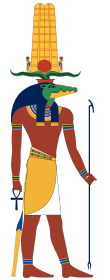Reptilian humanoid
Reptilian humanoids, or anthropomorphic reptiles, appear in folklore, fiction, and conspiracy theories.

In mythology
Many cultures have legends of creatures which are part human and part reptile. One of the first historical depictions of a reptilian humanoid was the Ancient Egyptian deity Sobek, who had the head of a crocodile. He was depicted with similar traits, such as being aggressive and animalistic.
In South Asian and Southeast Asian mythology, the Nāga are semi-divine creatures which are half-human and half-serpent.[1]
In folklore
Sightings of humanoid reptile cryptids are common in the Southern United States, where swamps are common. In the late 1980s, there were hundreds of supposed sightings of a "Lizard Man" in Bishopville, South Carolina.[2]
In fiction
Anthropomorphic reptilian races or beings commonly appear in fantasy and science fiction. They can be based on various reptiles, like crocodiles, alligators, snakes, dinosaurs, and the fictional dragons. They are often depicted as powerful warriors, though their relative intelligence to humans varies - as with other anthropomorphic races, a greater resemblance to humans often denotes more "civilized" behavior.
Fantasy
Games

Examples of reptilian races in fantasy games are the Lizardfolk, Dragonborn and Kobolds of the Dungeons & Dragons tabletop role-playing game.
The Dragonborn in particular - based on the Draconians of Dragonlance, which in that game were uniformly evil - were originally introduced in the Dungeons & Dragons 3.5 supplement book Races of the Dragon, published by Wizards of the Coast in 2006.[3][4] In 4th Edition, dragonborn are available as one of the core player character races in the Player's Handbook.[5][6]
The dragonborn were introduced to the core rules in an attempt to reflect contemporary trends in fantasy fiction and appeal to newer players.[7][8] In addition, it reflected a perception among the game's designers that it should be possible to play dragon-like creatures in a game with "Dragons" in the title.[7][9] Richard Baker, who helped design 4th Edition, noted that the introduction of dragonborn to the core rules allowed them to "grow the D&D world by allowing the mix of characters to evolve in the new edition."[9]
Jonathan Bolding of The Escapist noted that the inclusion of the dragonborn in the 5th edition Player's Handbook does "push the 'traditional D&D' mold a bit, but this is a greatest hits of D&D player races and powers from the last fifteen years of the game."[10]
The lizardlike Argonian race also takes a prominent role in the best-selling fantasy video game franchise The Elder Scrolls.
Science fiction
In works of science fiction, aliens are often depicted as closely resembling animals, with reptilian aliens being no exception. An early appearance was in the story "The Lizard-Men of Buh-Lo" (1930) by Francis Flagg.[11] Other examples include the Gorn from Star Trek, and the Dracs from the film Enemy Mine (1985).[11] The television franchise V features the Visitors, a lizardlike alien race who disguise themselves as humans.[11]
Conspiracy theories
The reptilian conspiracy theory alleges that shape-shifting reptilian aliens control Earth.[12]
See also
References
- "Naga | Hindu mythology". Encyclopedia Britannica. Retrieved 2019-09-11.
- Moran, Mark (2009). Weird U.S. : your travel guide to America's local legends and best kept secrets. Sceurman, Mark. New York: Sterling Pub. p. 112. ISBN 9781402766886. OCLC 244064142.
- "Races of the Dragon Excerpt".
- Kestrel, Gwendolyn F.M.; Wilkes, Jennifer Clarke; Liquette, Kolja Raven (2006). Races of the Dragon. Wizards of the Coast.
- "20 Things About Dungeons & Dragons That Make No Sense". ScreenRant. June 2, 2018.
- Heinsoo, Rob; Collins, Andy; Wyatt, James (2008). Player's Handbook. Wizards of the Coast.
- Tresca, Michael J. (2010). The Evolution of Fantasy Role-Playing Games. McFarland. p. 81.
- "D&D Player's Handbook: Then and Now". Wired. wired.com. 2008-07-30. Retrieved 2015-07-16.
- "Player's Handbook Races: Dragonborn (4e)". rpgnow.com. 2015-03-31. Retrieved 2015-07-21.
- "D&D Player's Handbook Review - A Greatest Hits Collection | Reviews | The Escapist". Escapistmagazine.com.
- The Greenwood encyclopedia of science fiction and fantasy : themes, works, and wonders. Westfahl, Gary. Westport, Conn.: Greenwood Press. 2005. pp. 15, 78, 319. ISBN 0313329508. OCLC 60401685.CS1 maint: others (link)
- "Conspiracy Theories". Time. 2008-11-20. ISSN 0040-781X. Retrieved 2019-09-11.